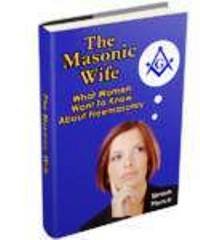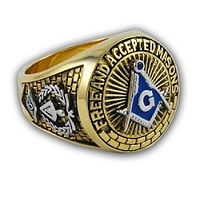Oldest Masonic Lodge
Which Lodge is the Oldest Masonic Lodge in the World?
Many Freemasons are curious as to what is the oldest Masonic
Lodge in the world.
So was I. I have always heard that Mother Kilwinning was the oldest,... but, alas,.. history may have proved me wrong. I hope you find this information as fascinating as I did.
Credit is given for the information, below to Past Grand Master of Missouri, Brother Ray V. Denslow, (1885-1960) author of "The Masonic World of Ray V. Denslow". Missouri Lodge of Research, publisher, 1964.
Brother Denslow also founded the Royal Arch Mason magazine in 1942 and was instrumental in founding the Missouri Lodge of Research.
The Oldest Masonic Lodge in the World
The oldest Masonic Lodge in the world (with verifiable lodge minutes) is the Lodge of Edinburgh No. 1, Edinburgh, Scotland...sometimes known as Mary's Chapel.
In July, 1949, it observed its 350th anniversary of its establishment. In 2008, (at the time of this writing), Lodge of Edinburgh No. 1 is 409 years old.
Oldest Masonic Lodge Minutes - July 31, 1599: Lodge of Edinburgh No. 1 has records to prove its long time existence as the Oldest Masonic Lodge.
Most impressively, its first 5 pages of minutes incorporate the Schaw Statutes which are dated December 28, 1598.
Six months later, on July 31, 1599, are to be found the minutes which confirm the lodge's claim as having the oldest existing Masonic minutes. It must be noted, however, that from these minutes there exists no conclusive evidence that the lodge was actually constituted on this date nor that it is, in actuality, the oldest lodge.
Schaw Statutes: The Schaw Statutes (part of the Old Charges) are named for William Schaw, who was Master of Work to His Majesty and General Warden of the Masonic craft. In these Statutes, he declared that theses ordinances issued by him for the regulation of lodges considered the lodge at Edinburgh to be for all time, the first and principal lodge in Scotland.
Lodge of Edinburgh No. 1 was first called "The Lodge of Edinburgh" and retained this name until 1688, when the Grand Lodge of Scotland confirmed its charter, designating it as "The Lodge of Edinburgh (Mary's Chapel) No. 1"
Prominent members belonging to the Lodge of Edinburgh in its very early days were:
- His Royal Highness, the Prince of Wales (afterward called King Edward VII)
- His Royal Highness King Edward VIII
Both were affiliated with the lodge, taking the obligation on the "Breeches Bible", which was printed in 1587. The pen with which these 2 brothers signed the roll is still preserved in the Edinburgh Lodge No. 1 museum.
Oldest Masonic Lodge
First Operative to Speculative in Scotland - 1600: As early as 1600, The Lodge of Edinburgh began to admit non-operative Freemasons. In June, 1600, the Laird of Auchinleck was made a speculative member, the first authentic record of the making of such a member.
The famous Dr. Desaguliers visited the The Lodge of Edinburgh on August 24, 1721. He had served as Grand Master of England and was referred to as "General Master Desaguliers". On the next day, while he was present, the Lord Provost of Edinburgh, the Treasurer, the Deacon Convener of the Trades and the Clerk to the Dean of the Guild Court were admitted as members.
This date is thought to mark the change over from operative to speculative Freemasonry in Scotland.
Inception of Grand Lodge of Scotland - 1736: When the Grand Lodge of Scotland was established on November 30, 1736, Lodge of Edinburgh took an active part. Thirty-three lodges were represented at the meeting which was held in the lodge room of Edinburgh Lodge. Because the oldest minute of a lodge was that of Edinburgh Lodge, it was placed first on the roll of the Grand Lodge.
Lodge Kilwinning - 1642: Lodge Kilwinning was the second oldest Masonic lodge because of its records dating to December 20, 1642. (It is believed there may be older lodges, but empirical proof has not been found.) Considerable friction developed in 1807 when the Grand Lodge of Scotland permitted Kilwinning to prefix the word "Mother" to its name.
Oldest Masonic Lodge
Should you wish to visit the oldest Masonic lodge in the world, I would be remiss not to mention that Edinburgh, Scotland is also home to Edinburgh Castle, standing 300-400 feet above the city. Lit up, even after dark, looking up you will see a virtual fairyland of turrets, battlements and castle buildings.
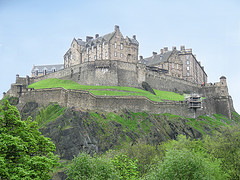
Edinburgh Castle..Courtesy of Robert Blumberg. All Rights Reserved.
Edinburgh Castle (pronounced Ed-in-burr-uh) dates back to 617 A.D., (nearly 1400 years ago) when Edwin, King of Northumbria, established a castle on the "Rock". The town growing up around it became "Edwin's Burgh", simplified into Edinburgh.
Its banquet hall, once used as a room for Parliament, is about 84 ft. x 33 ft and has an open timber roof, 45 ft. high. It was here in 1633, Charles I, and in 1648, Oliver Cromwell were entertained with opulence and great magnificence.
Decorations on the roof timbers bear the emblazonments of the arms of the principal governors and constables of the castle from 1007 to 1805. On its walls are weapons of war, defensive armor of various periods and flags of old Scottish regiments.
Edinburgh Castle Dungeons: Beneath it is a double tier of dungeons with small iron barred loop-holes used for prisoners from the middle of the 18th century (1700s) to Waterloo.
Edinburgh Castle Dog Cemetery For "Soldier "Dogs: Then, as now, loyalty is a highly regarded virtue by the Kings of Scotland. Edinburgh Castle is home to an immaculately kept dog cemetery for the soldier dogs of its Kings.
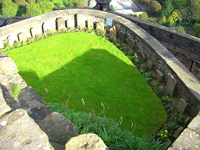
Dog Cemetery at Edinburgh Castle
Photo Courtesy of Jessee Wright
All Rights Reserved.
King George VI...Grand Master of Scotland: At a quarterly communication of the Grand Lodge, held November 5, 1936, they elected unanimously, Brother, His Royal Highness, the Duke of York, (later to become King George VI) as Grand Master of Scotland.
King George VI: It was also in Edinburgh Castle's Banquet Hall that the ceremony of the installation of the Duke of York, who later became King George VI, and who was the current Queen Elizabeth's father, was carried out on St. Andrew's Day, November 30, 1936. (the bi-centenary of the Grand Lodge of Scotland...in 1736)
Past Grand Master, Ray V. Denslow, the author of the book, attended this momentous ceremony at Edinburgh Castle.
Therefore, Edinburgh (Ed-in-burr-uh) Lodge No. 1 claims the rank of having:
- The Oldest Masonic Minutes
- The lodge of record where the first Operative to Speculative Freemasonry began.
...and, therefore, due to these documented Minutes, claims its title as the Oldest Masonic Lodge in the world.
and...now... for the Rest of the Story...
Lodge Kilwinning...the Oldest Masonic Lodge in the World??
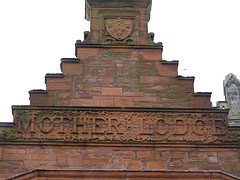
Mother Kilwinning Lodge
Photo Courtesy of H.P. Gray
All Rights Reserved
Here is what Albert Mackey had to say about the dispute
between the oldest Masonic lodge in the world being Edinburgh Lodge No. 1 or
Mother Lodge 0 Kilwinning:
Mackey's Revised Encyclopedia of Freemasonry, Page 517-518, 1929, published by
The Masonic History Company:
"As the city of York claims to be the birthplace of Freemasonry in England, the
obscure little village of Kilwinning is entitled to the same honor with respect
to the origin of the Order in the sister kingdom of Scotland.
The claim to the honor, however, in each case depends on the bare authority of a legend, the authenticity of which is now doubted by many Masonic historians.
The Abbey of Kilwinning is situated in the bailiwick of Cunningham, about 3 miles north of the royal burgh of Irving, near the Irish Sea.
The abbey was founded in the year 1140, by Hugh Morville, Constable of Scotland, and dedicated to Saint Winning, being intended for a company of monks of the Tyronesian Order, who had been brought from Kelso.
The edifice must have been constructed at great expenses and with much magnificence, since it is said to have occupied several acres of ground in its whole extent.
Traveling Freemason Architects: Lawrie (History of Freemasonry, page 46, 1859 edition) says that, by authentic documents as well as by other collateral arguments which amount almost to a demonstration, the existence of the Kilwinning Lodge has been traced back as far as the end of the 15th century.
But we know that the body of architects who perambulated
the Continent of Europe and have frequently been mentioned under the name of
"Traveling Freemasons", flourished at a much earlier period; and we learn, also,
from Lawrie himself, that several of these operative Freemasons traveled into Scotland,
about the beginning of the 12th century.
Hence, we have every reason to suppose that these men were the architects who
constructed the Abbey at Kilwinning, and who first established the Institution
of Freemasonry in Scotland.
If such be the fact, we must place the origin of the first Lodge in that kingdom at an earlier date, by 3 centuries, than that claimed for it by Lawrie, which would bring it much nearer, in point of time, to the great Masonic Assembly, which is traditionally said to have been convened in the year 926, by Prince Edwin, at York, in England. (See Old Charges)"
Edinbugh, Scotland is approximately 200 miles from York, England...a trip of about 4-1/2 hours by car.
King Robert Bruce "There is some collateral evidence to sustain the probability of this early commencement of Freemasonry in Scotland. It is very generally admitted that the Royal Order of Herodem was founded by King Robert Bruce, at Kilwinning.
Thory, in the Acta Latomorum, gives the following chronicle:
"Robert Bruce, King of Scotland, under the title of Robert I, created the Order of St. Andrew of Chardon, after the battle of Bannockburn, which was fought on the 24th of June, 1314.
To this Order was afterwards united that of Herodem, for the sake of the Scotch Freemasons, who formed a part of the 30,000 troops with whom he had fought an army of 100,000 Englishmen.
Grand Master King Robert Bruce: King Robert reserved the title of Grand Master to himself and his successors forever, and founded the Royal Grand Lodge of Herodem at Kilwinning."
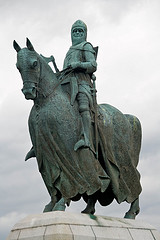
King Robert the Bruce - King of Scotland - 1306-1329
Standing on the Field at Bannockburn, Stirling, Scotland
Photo Courtesy David Hayes, Trossachs Photography
All Rights Reserved.
Doctor Oliver says that "the Royal Order of Herodem had formerly its chief seat at Kilwinning; and there is every reason to think that it and Saint John's Masonry were then governed by the same Grand Lodge."
In 1820, there was published at Paris a record which states that in 1286, James, Lord Stewart, received the Earls of Gloucester and Ulster into his Lodge at Kilwinning; which goes to prove that Lodge was then existing and in active operation at that place.
The modern iconoclasts, however, who are leveling these old legends with unsparing hands, have here been at work. Brother D. Murray Lyon has attacked the Bruce legend, and in the London Freemasons Magazine (of 1868, page 14), says:
"Seeing that the Fraternity of Kilwinning never at any period practised or acknowledged other than Craft degrees, and have not preserved even a shadow of a tradition that can in the remotest degree be held to identify Robert Bruce with the holding of Masonic Courts, or the Institution of a Secret Order at Kilwinning, the Fraternity of the "Herodim", must be attributed to another than the hero of Bannockburn, and a birthplace must be sought for it in a soil still more favorable to the growth of the high grades than Scotland has hitherto proved."
He, (Murray), intimates that the legend was the invention of the Chevalier Ramsay, whose birthplace was in the vicinity of Kilwinning.
Brother Mackey says, "I confess that I look upon the legend and the documents that contain it with some favor, as at least furnishing the evidence that there has been among the Fraternity a general belief of the antiquity of the Kilwinning Lodge."
Those, however, whose faith is of a more hesitating character, will find the most satisfactory testimonies of the existence of that Lodge in the beginning of the 15th century.
At that period, when James II was on the throne, the Barons of Roslin, as hereditary Patrons of Scotch Freemasonry, held their annual meetings at Kilwinning, and the Lodge at that place granted Warrants of Constitution for the formation of subordinate Lodges in other parts of the kingdom.
Kilwinning Subordinate Lodges: The lodges thus formed, in token of their respect for, and submission to, the mother Lodge whence they derived their existence, affixed the word Kilwinning to their own distinctive name; many instances of which are still to be found on the register of the Grand Lodge of Scotland---such as Canongate Kilwinning, Greenock Kilwinning, Cumberland Kilwinning, etc.
Grand Lodge of Scotland...in Edinburgh: But, in process of time, this Grand Lodge at Kilwinning ceased to retain its supremacy and finally its very existence. ...so in Scotland, the supreme seat of the Order was at length transferred from Kilwinning to the metropolis; and hence, in the doubtful document entitled the "Charter of Cologne", which purports to have been written in 1542, we find, in a list of 19 Grand Lodges in Europe, that that of Scotland is mentioned as sitting at Edinburgh, under the Grand Mastership of John Bruce.
Kilwinning Records Cannot Prove Itself as the Oldest Masonic Lodge: In 1736, when the Grand Lodge of Scotland was organized, the Kilwinning Lodge was one of its constituent Bodies, and continued in its obedience until 1743. In that year it petitioned to be recognized as the oldest Lodge in Scotland; but as the records of the original Lodge had been lost, the present Lodge could not prove, says Lawrie, that it was the identical Lodge which had first practiced Freemasonry in Scotland.
Kilwinning Lodge Secedes From the Grand Lodge of Scotland: The petition was therefore, rejected, and, in consequence, the Kilwinning Lodge seceded from the Grand Lodge and established itself as an independent Body.
Mother Kilwinning Lodge: "Mother" Kilwinning Lodge organized Lodges in Scotland; and several instances are on record of its issuing Charters as Mother Kilwinning Lodges to Lodges in foreign countries. Thus, it granted one to a Lodge in Virginia in 1758, and another in 1779 to some Brethren in Ireland calling themselves the Lodge of High Knights Templar.
Kilwinning Rejoins the Grand Lodge of Scotland: But, in 1807, the Mother Lodge of Kilwinning renounced all right of granting Charters, and came once more into the bosom of the Grand Lodge, bringing with her all her daughter Lodges.
Here terminates the connection of Kilwinning as a place of any special importance with the Freemasonry of Scotland."
...End of Albert Mackey reference information.
...and That...is the Rest of the Story about the dispute as
to which of these 2 Lodges is the Oldest Masonic Lodge in the World.
Simon-Sez:
Empirical evidence supporting the history of Freemasonry prior to the 18th Century (1700s) is difficult to find. The loss of evidence of the Minutes of Lodge Kilwinning from 1140 to 1642, which might well prove it to be the oldest Masonic lodge, is a very sad loss, indeed.
However, history can be reported only as accurately as it is recorded and passed down through the generations.
So...which of these 2 lodges is the Oldest Masonic Lodge in
the world? Empirical (historical) evidence going back this far is difficult (read this to mean: almost impossible) to find.
Dates of the chartered foundations of Lodge of Edinburgh No. 1, Mother Lodge Kilwinning No. 0 nor Lodge of Melrose St. John No. 1...all of which were in existence in and before 1598,...and all 3 of which are named with a zero or a one in their name, have not been found.
Therefore, while Lodge of Edinburgh No. 1 has in their possession the oldest Masonic lodge minutes, it may very well be possible that another lodge may, in truth, be able to claim the title of the oldest Masonic lodge in the world...if only they could prove their claim to this title.
Therefore, I'll let you decide from the evidence as to which is the oldest Masonic lodge in the world.
Grand Lodge Inception Dates:
England: 1717
Ireland: 1725
France: 1728 - (Grand Orient de France)
United States: 1730
Scotland: 1736
Consider a Masonic Trip To Scotland and Visit The Oldest Masonic Lodge
CONSIDERING A MASONIC TRIP?
If you are considering taking a Masonic trip, to visit the oldest Masonic lodge, Scotland is an excellent travel choice, as there is much to see and do,... most of which is within a 2 hour drive of Edinburgh.
Here are some of the places to see:
Edinburgh Castle: Edinburgh, Scotland. Take a tour of historic Edinburgh Castle, perched high upon the hill above Edinburgh.
The castle is home to military museums and contains the Scottish National War Memorial as well as the Honours of Scotland,... possibly the oldest royal regalia in Europe.
Members of the Royal Artillery fire the famous One O'Clock Gun from Edinburgh Castle's canons.
Lodge of Edinburgh No. 1: The oldest Masonic lodge in the world, Lodge of Edinburgh No. 1, is located on Hill Street in Edinburgh.
Grand Lodge of Scotland: Edinburgh, Scotland
United Grand Lodge of England: London,
England. About 400 miles south of Edinburgh.
Rosslyn Chapel: Rosslyn Chapel is in
Midlothian, Scotland...about 12 miles south of Edinburgh. Built in 1446 by
William St. Clair, and made mega-popular by Dan Brown's book and follow-up
movie, "The DaVinci Code"; it is filled with the intricately carved stonework of
operative stonemasons. Most interesting are the mason's marks on the
individual stones.
The Knight Templar tombstone, below, reads: "Knight Templar...13th Century".
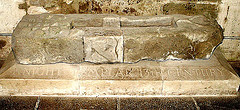
Knight Templar Tombstone in Rosslyn Chapel
Photo Courtesy Alex Young
All Rights Reserved.
Dunfermline Abbey: ...about 18 miles north
of Edinburgh. In 1329 Robert the Bruce died. His body is
buried in Dunfermline Abbey.
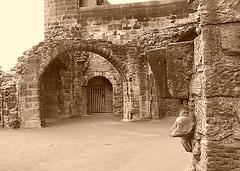
Dunfermline Abbey
Photo Courtesy of Alex Young.
All Rights Reserved.
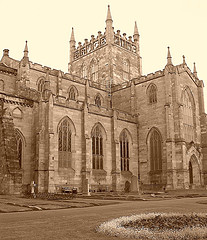
Dunfermline Abbey New Church
Photo Courtesy of Alex Young
All Rights Reserved
In 1818, when the site of the old Abbey Church (circa 1070) was being prepared for the new Abbey Church, Robert the Bruce's remains were discovered, wrapped in a cloth of gold and he was re-interred at Dunfermline Abbey in 1819.
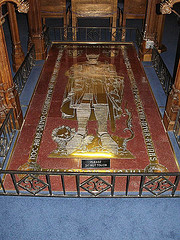
Robert The Bruce's Final Resting Place
Photo Courtesy Alex Young
All Rights Reserved.
Lodge of Dunfermline No. 26 - The Lodge of Dunfermline, No. 26, is rich in history. This history includes the numerous churches built by operative masons, royalty and many famous names.
In addition, it must be noted that in 1598, Warden Thomas Robertson, of the Ludge of Dunfermling and St. Andros, was one of the commissioners who confirmed the Schaw Statutes.
To read more about The Lodge of Dunfermline No. 26, visit The Lodge of Dunfermline, No. 26 page on The Grand Lodge of Scotland's website.
Robert the Bruce - Just before his death, Robert the Bruce asked that his heart be removed from his body and taken on a crusade by a worthy knight,... eventually to go to the Holy Land. His close friend, James Douglas honored this last request. Therefore, Bruce's heart was removed, embalmed and placed in a container that hung from Douglas's neck.
In the early spring of 1330, Douglas was in Spain battling the Moors when he found himself in an ill-fated battle, surrounded by the enemy. Once Douglas realized that his own death was imminent, he pulled the heart of his long dead king from his neck and threw it into the ranks of the enemy. Drawing his sword, he shouted
"Onward braveheart, Douglas shall follow thee or die."
A brave Scottish soldier fought his way through the lines and re-captured the small locked silver casket containing Robert the Bruce's heart, and brought it back to Scotland. He was knighted Sir Simon Lockhart of the Lee for his actions.
Melrose Abbey: Melrose, Scotland. (about 40 miles south of Edinburgh) Robert the Bruce's heart is buried at and memorialized at Melrose Abbey.
Bannockburn: About 30 miles north of Edinburgh, in Bannockburn, you can walk the famous battlefield where in 1314 King Robert the Bruce and the brave men of Scotland fought the decisive and significant battle toward winning Scottish independence from England.
Mother Lodge Kilwinning No. 0: (Possibly the oldest Masonic lodge in the world, but without the minutes to prove it) ...About 85 miles west of Edinburgh in Ayrshire. Mother Lodge Kilwinning has a wonderful Lodge Museum.
Edinburgh Hotels: There are over 195 hotels in Edinburgh. You can also stay at one of the many Royal Mile Hotels, to be close to shopping and restaurants.
Golf Scotland: St. Andrews Golf Course: If you are a golfer, about 60 miles north of Edinburgh is the famed St. Andrews Golf Course. Scotland has been regarded as the "home" of golf for over 6 centuries. You can play the links at St. Andrews, yourself, instead of watching Tiger Woods on television. St. Andrews Golf Course is also where Jack Nichlaus bid farewell to competitive golf in 2005.
Scotch Whiskey Heritage Center: Next to Edinburgh Castle. Learn how Scotch whiskey is made.
Scottish Distilleries: Sample some of the greatest Scotch in the world. Scotland has over 150 working distilleries and several whiskey producing regions. Most distilleries offer distillery tours that include a "wee dram". While there are many distilleries in Scotland, these 3 are among the closest to Edinburgh and the oldest Masonic lodge are:
Glenkinchie Scotch Whiskey Distillery: 15 miles southeast of Edinburgh.
Glenturret Distillery: Scotland's oldest distillery. About 60 miles north of Edinburgh.
Aberfeldy Distillery: Home of Dewar's. Tour the Dewar's Museum. About 75 miles north of Edinburgh
Take the family!
Traveling to Scotland and visiting the oldest Masonic lodge may very well be a once-in-a-lifetime event. But, it's not the only memorable thing to see in Scotland! Scotland is full of history.
There is much to do and see. After visiting the oldest Masonic lodge, you can go hiking in the clear air of the Highland peaks, visit Loch Ness, (home of Nessie), take walking tours, bus tours, visit the William Wallace (Braveheart) Memorial, as well as Stirling Castle, the former home of Mary Queen of Scots.
Edinburgh Shopping: Shop the Royal Mile in Edinburgh.
Scottish Scotland is famous for its knitwear, Scottish cashmere sweaters, and the finest of Scottish lambs wool. You can shop for Scottish bagpipes, Scottish kilts and Scottish tartan woolen products all made in Scotland.
So, don't take a Masonic trip to Scotland just to visit
the oldest Masonic lodge in the world.
Make the trip to transport yourself back through history to where you will be
able to experience Masonic education, first-hand.
Sometimes, we think of history as fascinating, but kind of set apart from our "here and now". Nothing could be further from the truth. Mother Lodge Kilwinning No. 0 and the Lodge of Melrose St. John No. 1 are both active, working Masonic lodges.
For those of you who would like to read more about their respective history directly from their own websites, I am including a link to each of their lodge websites, below, so you can explore them for yourself.
Mother Kilwinning No. 0
Linking In: If you would like to link to this website or this page to assist other brothers learn more about the oldest Masonic Lodge and improve their Masonic education, please feel free to do so.
If you would like to bookmark this page about the Oldest Masonic Lodge, Social Bookmarking links are placed at the bottom of the page.
Related Pages:
5 Fast Methods To Find the Information You Want to Learn About
- Search Box - Use the Search Box at the top of your page.
- Site Map - Use my Site Map page to find the topics you are most interested in.
- Carousel - Use the carousel of pages at the top of your screen.
- Menu Icon - On MOBILE, click the MENU button at the top of each page.
- Masonic Books - Browse through a selection of Masonic books.
